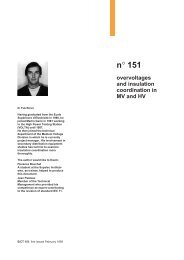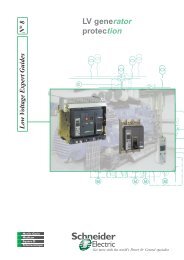sepam 20 user manual - Schneider Electric
sepam 20 user manual - Schneider Electric
sepam 20 user manual - Schneider Electric
Create successful ePaper yourself
Turn your PDF publications into a flip-book with our unique Google optimized e-Paper software.
3<br />
Protection functions General<br />
Tripping curves<br />
Presentation of tripping curve operation and<br />
settings for protection functions using:<br />
b definite time<br />
b IDMT<br />
b timer hold.<br />
3/36<br />
MT10911<br />
DE50666<br />
Definite time protection<br />
The tripping time is constant. The time delay is started when the set point is overrun.<br />
t<br />
T<br />
Definite time protection principle.<br />
IDMT protection<br />
The operation time depends on the protected value (phase current, earth fault<br />
current, etc.) in accordance with standards IEC 60255-3, BS 142 and IEEE C-37112.<br />
Operation is represented by a characteristic curve, e.g.:<br />
b t = f(I) curve for the phase overcurrent function<br />
b t = f(I0) curve for the earth fault function.<br />
The rest of the document is based on t = f(I); the reasoning may be extended to other<br />
variables I0, etc.<br />
The curve is defined by:<br />
b its type (standard inverse, very inverse, extremely inverse, etc.)<br />
b current setting Is which corresponds to the vertical asymptote of the curve<br />
b time delay T which corresponds to the operation time for I = 10 Is.<br />
These 3 settings are made chronologically in the following order: type, Is current,<br />
time delay T.<br />
Changing the time delay T setting by x % changes all of the operation times in the<br />
curve by x %.<br />
t<br />
T<br />
Is<br />
type 1<br />
type 1,2<br />
1 1,2 10 <strong>20</strong> I/Is<br />
IDMT protection principle.<br />
The tripping time for I/Is values less than 1.2 depends on<br />
the type of curve selected.<br />
I<br />
Name of curve Type<br />
Standard inverse time (SIT) 1, 2<br />
Very inverse time (VIT or LTI) 1, 2<br />
Extremely inverse time (EIT) 1, 2<br />
Ultra inverse time (UIT) 1, 2<br />
RI curve 1<br />
IEC inverse time SIT / A 1<br />
IEC very inverse time VIT or LTI / B 1<br />
IEC extremely inverse time EIT / C 1<br />
IEEE moderately inverse (IEC / D) 1<br />
IEEE very inverse (IEC / E) 1<br />
IEEE extremely inverse (IEC / F) 1<br />
IAC inverse 1<br />
IAC very inverse 1<br />
IAC extremely inverse 1<br />
b when the monitored value is more than <strong>20</strong> times the set point, the tripping time is<br />
limited to the value corresponding to <strong>20</strong> times the set point.<br />
b if the monitored value exceeds the measurement capacity of Sepam (40 In for the<br />
phase current channels, <strong>20</strong> In0 for the residual current channels), the tripping time is<br />
limited to the value corresponding to the largest measurable value (40 In or <strong>20</strong> In0).<br />
PCRED301005EN - 06/<strong>20</strong>08

















